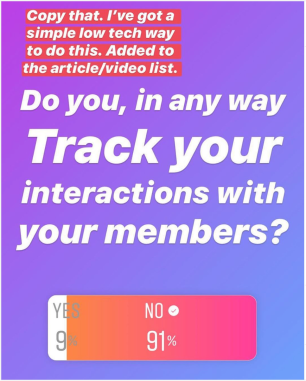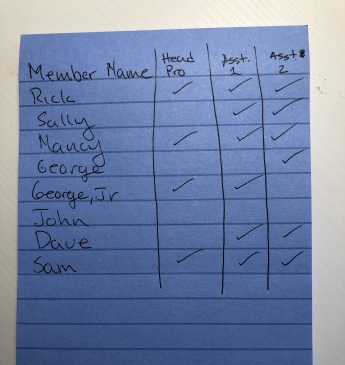I can already hear you saying it…….
“You want me to keep track of the interactions I have with every member?! I just had one of my golf staff call out sick, my cart person never showed up this morning and i’ve got 144 on the tee sheet. Right now all I am worried about is getting these players to the tee and around the course in less than 6 hours without anyone getting hurt.”

Or, maybe that’s just what I was thinking.
When I was asked to come up with a member retention initiative for the fall and winter season, my first thought was, ‘How can I make this work without having to do more work I don’t have time for.’ Now, that’s not to say I didn’t believe it was important. I just knew that if I was able to design the program where I could actually execute it in a way that mattered, I had a chance of making it work.
The key to the success of this program was my manager allowing me to create it based on what I thought would have the biggest impact. He would have to agree with the idea, but I got to come up with it. And that is probably why it worked. It has to make sense to him, but first it had to make sense to me, since I would be running it.
Many mangers make the mistake of doing the opposite. They come up with an idea for retention because the math looks good on the financials, tell the staff what they are supposed to do, and give them a report to fill out to prove they are doing it. This changes the focus of many pros to ‘how to I get this report done?’ Rather than ‘how do I achieve the goal.’
I personally have been in both situations. I have seen this retention program reduce winter member resigns by 25% in one year to record lows. And I have seen that same number yo-yo back up above record highs when minimal support and staffing levels by ownership and management are not maintained.
Who’s most at risk of leaving?
The idea for this program was inspired by a story you may have heard.
The story goes, that at a private club, the golf staff got together and listed the 20 members they thought were most at risk of leaving the club that coming Winter. The Head Professional arranged to play at least 9 holes with each of them before the end of the season. Can you guess how many of those members were still at the club at the end of the winter? All of them.
Now, I have also heard similar case studies that have this number at more like 25% resigning, but even with this more conservative math, the results are still pretty impressive.
Or are they?
Are “at risk” members really that at risk of leaving? Have you ever tried to kick an “at risk” member out of your club? They hang on for dear life like you hold onto that To-Go burger you grabbed from the kitchen 6 hours ago that’s still sitting on your desk. – “Yes, you can use my computer to setup the tournament. BUT DON’T TOUCH MY BURGER!”
And if you know someone well enough to think they are likely to leave the club, haven’t you probably done enough to help keep them already without further pandering to their every whim and demand? What about the other 480 members of your club? Just because they go about their business, paying dues, and not making a fuss, are they not entitled to some attention? I certainly thought it was time to give them some attention. They are 95% of your dues paying members after all.
The Process
Our focus became establishing a connection with members where there wasn’t already one. We needed a way to determine who we needed to focus on, rather than just trying to connect with members we already knew well. We needed a benchmark to determine who we hadn’t made a connection, a plan for connecting and with and a system tracking our progress and results.
To start, I went and printed out our entire member roster. I made a column down each page for me and each of may Assistant Professionals. It’s easiest if you can import the members into a spreadsheet to do this. Each of us took a run through the list. If we read a members name and immediately could picture them, then we put a check mark next to their name. (See example. I wish I could find my originals.)

For any member that we all knew, we removed their name from the list (in the example, Rick, Nancy and Sam would be removed). We then printed out the remaining names. So, what we had left was a list of members at least one of us didn’t know well enough to check off. Out of about 500 golf members, I think I had 160 names still left under my name. Overall, there were about 230 members at least one of us didn’t know super well.
Over the next two months, that filtered list lived at the golf shop counter. When each of us would arrive, we would look at the tee sheet and see if there were any members on that list. We would then add a note to notify that staff member when the member arrived.
The goal of the program was to have one personal interaction with every member on that list when they came out. Sometimes the interaction was short because you remembered the member and some things about them the moment you saw them. In that case a handshake and a simple, “Hello, great to see you out playing.” or “Did you get your daughter moved into college OK?” would suffice. Other times you may need to drive out on the course to introduce yourself to a new member you haven’t met yet.
The level of interaction depends on the circumstance of that relationship. It’s not about what was said so much as just connecting. Hopefully, just the gesture of taking the time is enough for them to feel a connection to you and the club. If not, and you don’t remember them a week later, don’t worry. We have a list for that.
We also made if fun by coming up with a leaderboard. We tracked our totals on the whiteboard in the office. The goal was to get the list as small as we could by season end. We tracked the results by the percentage of members you were able to check off your list since staff started with different numbers. I didn’t lose, but I still ended up buying the beers for the team to celebrate.
The Results
In those last two months of the season we reduced that list in half from over 200 members to just over 100 members and had missed only one member that was on our list who visited during that time.
It was a short program but that winter our resignations went from 121 the year before to 87 that year. At a club that sells a lot of new membership each year and has a lot of people resign that 34 members was a retention record in the recorded history we had access to. At an average annual dues only value of $5,000 per member that means we started the next year $170k ahead of forecast.
Of course we didn’t get to see everyone in person at the club. Like I said, there were still 100 members or so we didn’t see in those last 2 months of the year. So, our General Manager made sure to organize a handwritten note campaign to go along with our efforts. Each manager took part of the membership to write a handwritten thank you note to members thanking them for being a member.
Learnings and Opportunities
While we did this effort to directly impact retention in the coming winter months. I think that constantly revisiting this process can have a great impact on membership satisfaction and retention year round.
It is always one of my first recommendations to professionals, of all levels taking a job at a new facility. Print out a member roster, or handicap list if you are public, and see how many members you can get to know over your time there. And if you have access to it, compare how those members do in retention and revenue generation compared to others. It could be a great thing to include in your resume if you can show a connection between the two.
Since I wanted to keep this solution “low-tech”, I left out the opportunity to scale this interaction online. By using online platforms and social media, I could have connected with many more of the members who didn’t make it out to the club in the those last couple months and through the winter.

